Samoan 20 Talas
2018-09-17 Mon
Samoa is a country comprising of the westernmost group of the Samoan Islands, in Polynesia. Many of its islands have reef-bordered beaches and rugged, rainforest interiors with gorges and waterfalls. The islands include Upolu, home to most of Samoa's population, and Savai'i, one of the largest islands in the South Pacific. Smaller islands may have small villages or be uninhabited, some with wildlife sanctuaries.The Lapita people discovered and settled the Samoan Islands around 3,500 years ago. They developed a unique Samoan language and Samoan cultural identity. The United Nations has classified Samoa as an economically developing country since 2014.
The country's currency is the Samoan Tala, issued and regulated by the Central Bank of Samoa. It is divided into 100 sene. The Tala was introduced on 10 July 1967, following the country's political independence from New Zealand in 1962. The Samoan currency is issued and regulated by the Central Bank of Samoa.
Today we are discussing Samoa’s 20-tala currency note issued in the year 2008. With vivid colours, beautiful hues and a lovely Sinaloa Waterfall (220 m tall) in south-central Savaii, the highest waterfall in the Samoan archipelago, this banknote sports Samao’s magnificent ecology on the obverse.
The reverse depicts the national bird of Samoa, Manumea, Tooth-billed Pigeon (Didunculus Strigirostris), also known as Samoan Pigeon and the national flower, Teuila - Red Ginger (Alpinia purpurata), also called Ostrich Plume and Pink Cone Ginger. The banknote also features the Coat of Arms of Samoa along with the signatures of the Minister of Finance and the Governor.
Image Courtesy: MatinMarkka
Latest News
-
Janma Kalnayak of Bhagwan Mahavir
2024-04-24 WedOn 21st April 2024 which was the 2550th Janma Kalnyanak of Bhagwan Mahavir Swami, PM Modi unveile...
-
Gold Pagoda of Vijaynagar Empire King Deva Raya I
2024-04-10 WedKing Deva Raya I of the Vijayanagara Empire was a patron of Kannada literature and architecture. He ...
-
Silver Denarius of Septimus Severus
2024-04-05 FriLucius Septimius Severus served as the Roman emperor from 193 to 211 AD. Severus sat on the throne o...
-
Extremely rare 'Malaharamari' type Gold Gadyana of King Guhalladeva-III Sold for INR 611000
2024-04-03 WedTribhuvanamalla, also known as Guhalladeva III, was the ruler of the Kadamba dynasty. His reign coin...
-
90 Years of RBI
2024-04-02 TueOn 1st April, PM #Modi unveiled a special commemorative coin marking 90 Years since the foundation o...

